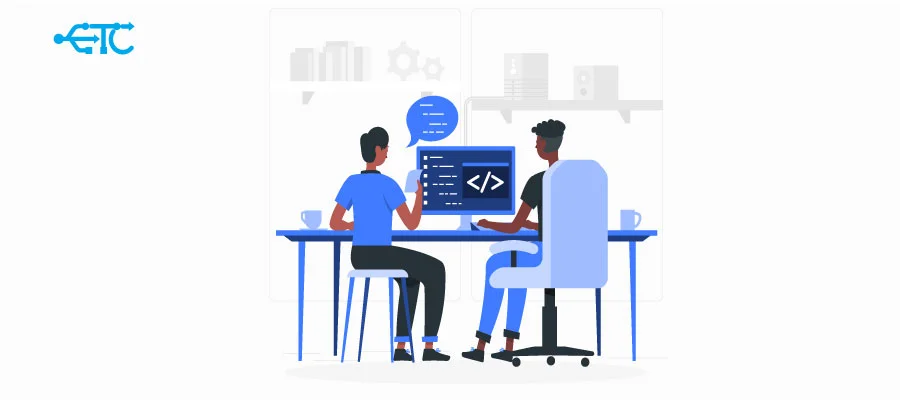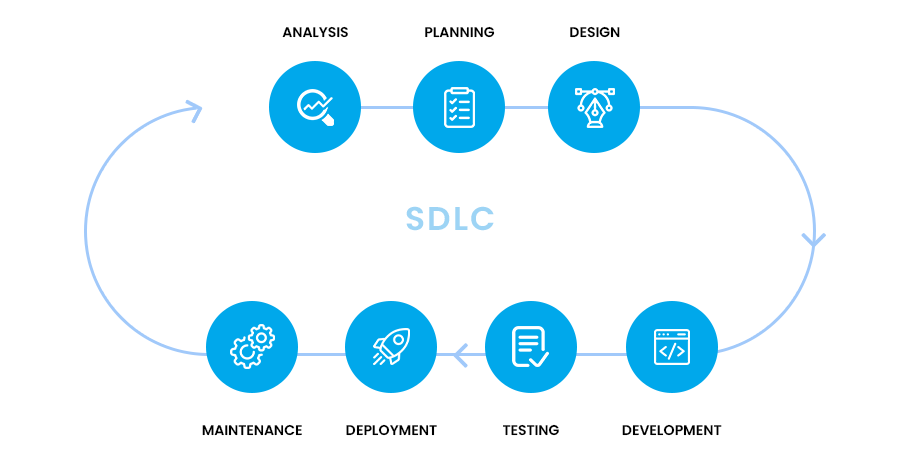Software Development Life Cycle (SDLC)

Listen to this article
The software development life cycle refers to the process of planning, designing, developing, testing, and deploying information systems including both hardware and software.
What is software development lifecycle ( SDLC ) ?
Software development lifecycle (Life cycle of an IT project) refers to the design, high quality software development and testing. SDLC (more clearly Software Development Life Cycle), defines the complete development cycle. In other words, SDLC combines the different operations that are part of the planning, creation, testing and deployment of any software product. In what follows, we detail the SDLC operation as well as its different stages.
We also introduce you to the different SDLC models to better understand how they work.
What are the phases of SDLC ?
Software development cycle is defined as the sequence of steps producing the highest quality software and lowest costs in an extremely short period of time.
SDLC provides a well-structured flow of steps. These help any institution quickly produce a high quality software. It will also be well tested and ready to use. In terms of software development, the SDLC is detailed as follows:

1️⃣Analysis
In this phase, designers begin by identifying, gathering and defining current customers’ problems, requirements, requests and expectations related to the software product.
This involves collecting comments from the various parties concerned, including customers, vendors, industry professionals and programmers. It gives the teams working below the necessary foresight and context to deliver and produce their software solutions.
2️⃣Planning
At this stage, the team determines the budget and resources needed for the fulfilment of the requirements analyzed without forgetting to check the risks incurred. The team provides also the plans needed to overcome these risks. This way, the feasibility of the project is well studied. As such, the team takes upon itself to think about the best way to to carry out the projet successfully.
3️⃣Design
During this step, the transformation of the software specifications into a design plan of is launched. The latter is called design specification.Designers make software design decisions regarding the architecture of the software solution. This involves the creation of design documents, coding guidelines and tools discussion, practices, execution environments or frameworks that help the team meet software specifications and requirements and the objectives defined during the requirements gathering phase. During this step, you need to have a working plan allowing stakeholder comments to be incorporated into these documents, after they have been collected.
4️⃣Software Development
At this stage of SDLC, development team builds software solutions on the basis of design decisions made. Technical managers and project managers are responsible for unlocking the process, decision-making and technical assistance. This stage of work ends once that the teams have packaged and built their code.
5️⃣Testing
At this stage, a software implementation is packaged and tested to ensure quality. Tests are carried out to ensure that the solutions implemented meet quality and performance standards. This may involve either unit testing,integration and end-to-end testing, verification or validation as well as error reporting or identification or defects in the software solution.
6️⃣Deployment
This means deploying the software in the production environment. Users will then be able to start using it.
7️⃣Maintenance
The goal of this SDLC stage is ensuring that needs continue to be met and that the system continues to operate according to the specifications mentioned in the first phase. After the deployment phase, as well as the use in the first place by customers, this is what happens:
- Correction of errors reported due to unforeseen and untested circumstances.
- Updating application features for better compatibility with recent software versions.
- Introduction of new added options.
What are the main models of SDLC ?
During the software development process, experts are responsible for monitoring designed SDLC life cycle models. In adapting to its type, each of these models goes through different phases.This ensures the success of software development process as a whole.
Here are the most famous SDLC models :
1️⃣ Waterfall model
Considered both the oldest and the simplest of all, this model is divided into several phases. Each phase has its own plan and starts after the previous one. The result of the first phase will represent the entry point of the following phase. This model requires a lot of documentation that can be easily found at each phase, at the level of the previous phase. Only you have to pay attention to one point. All details, even the smallest ones, must be completed. If not, the whole process will be delayed.
2️⃣ Iterative model
Here, it is the repetition that is in the spotlight. Indeed, during this SDLC model, the designers develop a fast and cheap version to then improve it as the tests progress by other versions, which are also rapid and successive. The main drawback this model has is that it can quickly consume resources if left unchecked.
3️⃣ Spiral Model
It is the most flexible model among SDLC models. It is similar to the iterative model in the sense that it focuses predominantly on repetition. Initially, the developers plan the different stages, design the software and build it, before testing it, in the end. With each pass, new improvements are made.We can consider that the spiral model is a successful combination of the advantages of prototyping models and that of the cascading one (speed and simultaneity in design and development activities).
4️⃣ Model –V
In this SDLC model type , the different phases are planned in parallel. The software verification and validation phases are done in parallel, simultaneously.
5️⃣ Big Bang Model
This is a high risk model. Without necessarily having to plan ahead, this SDLC model concentrates all its resources on development. However, the in-depth definition stage of requirements is not there, unlike the other methods. Requirements are implemented as they arise and work best for small projects as well as academic ones. Development team must be small in size even if in this model, requirements are unknown as is the final release date.
6️⃣ Incremental model
These are several cycles, revised in cascade, with requirements shared in groups from the start of the project, while following the software planned development. The SDLC life cycle process gets repeated, and with each repetition new functionalities are added until all requirements are met.As soon as the incremental model is modified, development cycles automatically overlap. Indeed, it is quite possible that a cycle starts before the previous one is finished.
What are the benefits of SDLC?
Software development life cycle is useful to allow the highest level of management control and documentation and this is the way developers understand their tasks and purpose.
The different parties together set a goal from the start and draw up the appropriate plan to achieve.
The main advantages of using SDLC are the following :
- Downward revision of the software development cost.
- Improving the quality of software provided by the anization.
- Shortening development times by preventing after-the-fact fixes.
- Helping developers better understand what they build and why.
- Ensuring that all stakeholders are allowed to give their opinion from the first stages of development.
- Giving all members of the development team an understanding of the cost and necessary resources to carry out the project efficiently.
What are the limitation of SDLC?
In addition to the advantages, SDLC presents certain some disadvantages:
- Reducing communication and collaboration between departments:
Since SDLC is a linear model and seen that the organisation does not move to the next step as long as the current step is not completed, this approach can have the effect of creating silos of information. - Not allowing much flexibility:
An SDLC model can make an organization excessively dependent on the process. - Creating a single point of failure in the early stages:
The team defines the product whole development plan depending on the collection and analysis of initial needs. However, this first phase can lead to a failure of the product if the team does not evaluate market needs correctly.
Conclusion
For the project to be successful, it is essential to respect the life cycle already drawn. It is indeed possible to come across different software development life cycle models.
Each model has a number of advantages and limits. Whatever the project you are aiming for, the requirements, the complexity of the system, the size, the budget… are so many determining factors of the best SDLC model to opt for.
